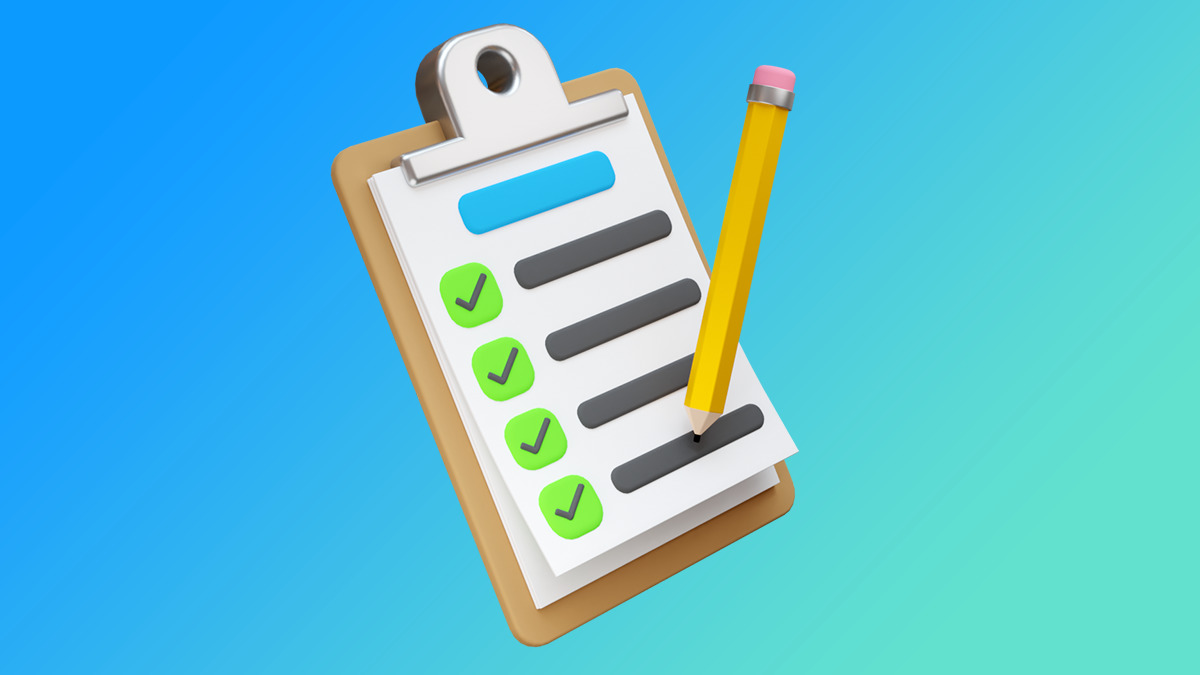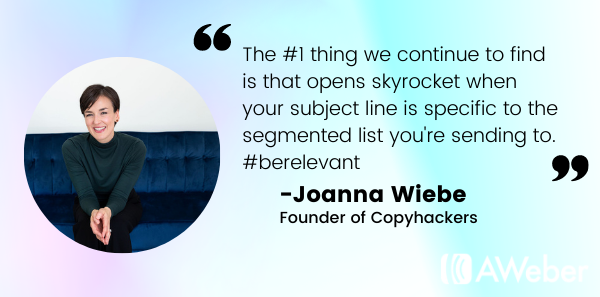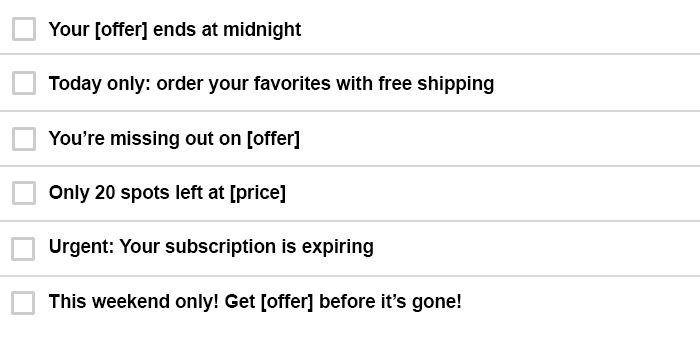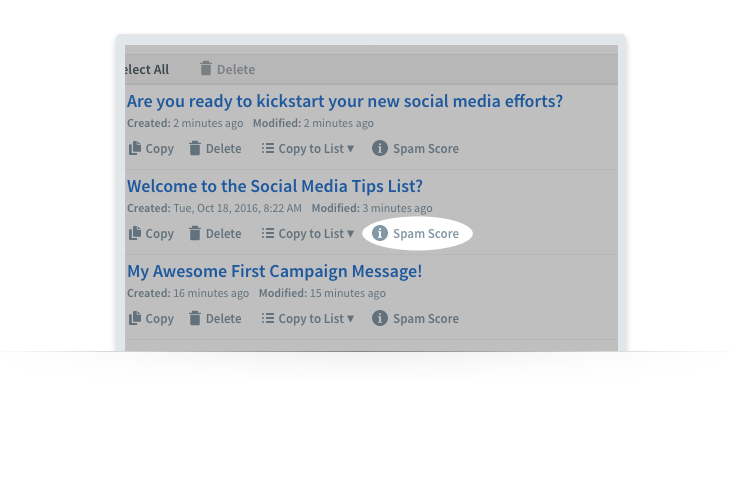
Your subject line can single-handedly make or break your entire email campaign. We put together this list of best practices to help you create attention-grabbing subject lines for your email marketing campaigns.
Email subject line best practices
- Personalize your email subject lines
- Use segmentation
- Create urgency with FOMO
- Avoid spam triggers
- Be direct
- Ask questions
- One word subject lines
- Super long subject lines
- Understand your audiences' pain points
9 email subject line best practices
Personalize your email subject lines
Do any of these subject lines catch your attention?

Not particularly.
Many years ago when companies first started using first name personalization, it worked. It grabbed your attention. But now, variations of “Hello {!firstname_fix}” have become the norm in email marketing, not the outlier. Because of that, it’s lost its novelty.
But that’s not the type of personalized email subject line I’m talking about. To truly create an email subject line that gets attention, you need to make the content unique to that individual subscriber.
You need to go above and beyond to connect with each customer. You can do this by personalizing your message based on location, past purchase behavior, and content they’ve engaged with. Think of what information you have on your customers. Now use that to create a personalized experience for them.
What if I took the same email blast subject lines examples above, but made them personalized based on my experiences with those brands?

Now that made a difference.
So what’s the best way to accomplish this? With your next email subject line best practice - segmentation.
Use segmentation
At AWeber, we recommend segmenting your audience and sending each segment tailored messages with unique subject lines.
Joanna Wiebe, Founder of Copyhackers, agrees: "The #1 thing we continue to find is that opens skyrocket when your subject line is specific to the segmented list you're sending to."

Here are some ways to do just that:
- Ask questions on your sign up form.
Then use that information in your email subject lines. For example, if you write a fashion blog, you can ask your subscriber for his or her favorite color when they sign up to your mailing list. Then, you can send them emails based on their color choice — like “15 gorgeous [color] dresses under $50.” - Send location-based emails.
Traveling to a conference? Speaking at an event? Meet up with your subscribers in different cities. “We’re in [city] next week! See you there?” - Retarget subscribers.
Did a subscriber abandon a product in his or her shopping cart? You could send an email like “Forget something? Here’s a 20% off coupon!” Or did a subscriber not follow through on an action, like registering for your webinar or workshop? Use that info to tailor their next message. “Only 12 hours to sign up for [event]!”
Create urgency in your subject line with FOMO
Fear of missing out — or FOMO — is a powerful psychological driver of email opens and engagement. Email subject lines that create a sense of urgency, scarcity, and exclusivity can boast a 22% higher open rate.
This can be done by giving your subscribers a deadline to accomplish an action.
Here are some other effective FOMO email subject line examples:

Avoid spam triggers in your subject line
Email spam filters are triggered by specific words, phrases, and symbols in your subject line and email content. AWeber uses a content filtering tool called SpamAssassin™ to help you avoid content filtering. This tool is widely used by internet service providers (ISPs) to filter incoming email.

By clicking on that score, you can instantly view the content in your messages that are triggering the SpamAssassin™ ruleset.
So what are some words, phrases, and symbols that are red flags to spam filters? There are a ton, but here’s a few to give you an example:
- Excessive punctuation like multiple exclamation points!!!!!!! or ellipses ………
- TYPING IN ALL CAPS
- Symbols like “$$$” and “*****”
- Phrases like “cheap,” “cash off,” “incredible deal,” “satisfaction,” “winner”
Also, as many as 69% of email recipients report email as spam based solely on the subject line. Make sure your subject line doesn’t come across as spammy to your subscriber, too. This will happen if your subject line is deceiving in any way, such as leading with “RE:” when it’s not an actual reply to an email.
Be direct in your subject line
Skip the wit, wordplay, humor, rhymes, or puns in your subject lines.
Stick with straightforward headlines instead. These “boring” subject lines convert extremely well. That’s because they explain the value inside the email. The readers know exactly what to expect from the message and the benefits they’ll receive from opening it.
Here are some straightforward email subject line examples:

But there’s one catch: Your messages have to consistently provide value. If your messages fall short of their promised value, your subscribers will feel cheated. Then, good luck getting them to open your messages moving forward.
However, if your emails are constantly packed with important, personalized content, your audience will open your emails — no matter what the subject line says.
Ask questions to pique curiosity
There’s a reason most television season finales end with cliffhangers: Humans crave nice-and-neat endings. So when you don’t give it to them, they’re unsettled. They have to know what happens next, and they’ll tune in the next season for closure.
Use this craving to your advantage. Fuel your subscribers to open your emails by injecting curiosity into your subject lines. You can ask a question:
- Jo at Copy Hackers: “Are you missing these 3 copy techniques?”
- Men’s Health Daily Dose: “Will Creatine Boost Your Gains?”
Or promise an answer inside your message:
- Jessica Stansberry: “You should be going live ___ times per month! [open for the answer]”
- Sophie Gray: “This is the ONLY Reason You Should Workout”
Or tease a surprise, giveaway, or gift:
- AWeber Blog: “We made free Fall GIFs for you!”
Or make readers say “huh?!”
- Chubbies: “Sincerely, future Dwight”
- Really Good Emails: “Emails can be tasty"
Use one word subject lines
Another piece of advice from Copyhackers' Wiebe? Try one word subject lines.
Why? One word subject lines can be intriguing.
Here at AWeber, we've sent one word subject lines that wind up having a higher open rate than average.
Or super long subject lines
Wait, didn't you just say try one word subject lines? Yes, yes I did.
But the reality is both really short and really long subject lines can work well. Ultimately, it's all about standing out and finding what works for your audience.
In fact, only 18% of people include more than 60 characters in their subject lines. So why not give it a go?
Understand your audiences' pain points
Wiebe advises, "Put your audiences' pain points, fears or amazing outcomes in quotation marks and use the first person."
This formula could help your audience see themselves in your subject line. Because they feel aligned to the copy, they'll be more likely to open it to see what you have to say.
Again, this all goes back to knowing your audience. When you understand your audience — their hopes, dreams, fears, challenges and more — you can create copy that resonates with them and drives them to action. You have to include a value proposition that appeals to them.
As Wiebe says: "Because, of course, the copy in your subject line is only one small part of the equation when it comes to getting opens."
What email subject line best practices work for you?
Has something worked for you that we didn't share in this post? Comment below! We'd love to hear what works for you.
The post Email Subject Line Best Practices To Get More Opens appeared first on AWeber.
from AWeber https://ift.tt/3yhA2Nn
via IFTTT
No comments:
Post a Comment